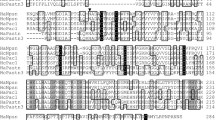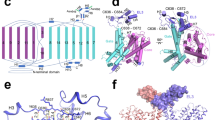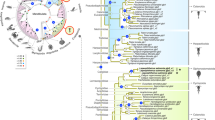Abstract
IN mammals, active transport of organic solutes across plasma membranes was thought to be primarily driven by the Na+ gradient1–3. Here we report the cloning and functional characterization of a H+-coupled transporter of oligopeptides and peptide-derived antibiotics from rabbit small intestine. This new protein, named PepT1, displays an unusually broad substrate specificity. PepT1-mediated uptake is electrogenic, independent of extracellular Na+, K+ and Cl−, and of membrane potential. PepT1 messenger RNA was found in intestine, kidney and liver and in small amounts in brain. In the intestine, the PepTl pathway constitutes a major mechanism for absorption of the products of protein digestion. To our knowledge, the PepT1 primary structure is the first reported for a proton-coupled organic solute transporter in vertebrates and represents an interesting evolutionary link between prokaryotic H+-coupled and vertebrate Na+-coupled transporters of organic solutes.
This is a preview of subscription content, access via your institution
Access options
Subscribe to this journal
Receive 51 print issues and online access
$199.00 per year
only $3.90 per issue
Buy this article
- Purchase on Springer Link
- Instant access to full article PDF
Prices may be subject to local taxes which are calculated during checkout
Similar content being viewed by others
References
Crane, R. K., Miller, D. & Bihler, I. in Membrane Transport and Metabolism (eds Kleinzeller, A. & Kotyk, A.) 439–449 (Czech. Acad. Sci., Prague, 1961).
Wright, E. M., Hager, K. M. & Turk, E. Curr. Opin. Cell Biol. 4, 696–702 (1992).
Ganapathy, V., Brandsch, M. & Leibach, F. H. Physiology of the Gastrointestinal Tract 3rd edn (ed. Johnson, L. R.) 1773–1794 (Raven, New York, 1994).
Tsay, Y.-F., Schroeder, J., Feldmann, K. A. & Crawford, N. M. Cell 72, 705–713 (1993).
Perry, J. R., Basral, M. A., Steiner, H.-Y., Naider, F. & Becker, J. M. Molec. cell. Biol. 14, 104–115 (1994).
Kaback, H. R. Biochim. biophys. Acta 1101, 210–213 (1992).
Kanai, Y., Smith, C. P. & Hediger, M. A. FASEB. J. 7, 1450–1459 (1993).
Truppathi, C., Ganapathy, V. & Leibach, F. H. J. biol. Chem. 265, 14870–14874 (1990).
Daniel, H. & Adibi, S. A. J. clin. Invest. 92, 2215–2223 (1993).
Lombardo, Y. B., Morse, E. L. & Adibi, S. A. J. biol. Chem. 263, 12920–12926 (1988).
Adedoyin, A., Perry, P. R. & Wilkinson, G. R. Drug Metab. Dispos. 21, 184–188 (1993).
Adibi, A. A. & Mercer, D. W. J. clin. Invest. 52, 1586–1594 (1973).
Ganapathy, V., Burckhardt, G. & Leibach, F. H. Biochim. biophys. Acta 816, 234–240 (1985).
Dyer, J. et al. Biochim. J. 269, 565–571 (1990).
Thwaites, D. T., Brown, C. D. A., Hirst, B. H. & Simmons, N. L. J. biol. Chem. 268, 7640–7642 (1993).
Abe, M., Hoshi, T. & Tajima, A. J. Physiol. 394, 481–499 (1987).
Kramer, W. et al. Eur. J. Biochem. 204, 923–930 (1992).
Sinko, P. & Amidon, G. J. pharmac. Sci. 78, 723–727 (1989).
Kanai, Y. & Hediger, M. A. Nature 360, 467–471 (1992).
Lucas, M. Gut 24, 734–739 (1983).
Ganapathy, V. & Leibach, F. H. J. biol. Chem. 258, 14189–14192 (1983).
Siebens, A. W. & Boron, W. F. J. gen. Physiol. 90, 799–831 (1987).
Davis, B. A., Hogan, E. M. & Boron, W. F. Am. J. Physiol. 263, C246–C256 (1992).
Kanai, Y., Lee, W.-S., You, G., Brown, D. & Hediger, M. A. J. clin. Invest. 93, 397–404 (1994).
You, G. et al. Nature 365, 844–847 (1993).
Parent, L., Supplisson, S., Loo, D. D. F. & Wright, E. M. J. Membr. Biol. 125, 49–62 (1992).
Mager, S. et al. Neuron 10, 177–188 (1993).
Hediger, M. A., Coady, M. J., Ikeda, T. S. & Wright, E. M. Nature 330, 379–381 (1987).
Hediger, M. A., Mendlein, J., Lee, H.-S. & Wright, E. M. Biochim. biophys. Acta 1064, 360–364 (1991).
Wells, R. G. & Hediger, M. A. Proc. natn. Acad. Sci. U.S.A. 89, 5596–5600 (1992).
Author information
Authors and Affiliations
Rights and permissions
About this article
Cite this article
Fei, YJ., Kanai, Y., Nussberger, S. et al. Expression cloning of a mammalian proton-coupled oligopeptide transporter. Nature 368, 563–566 (1994). https://doi.org/10.1038/368563a0
Received:
Accepted:
Issue Date:
DOI: https://doi.org/10.1038/368563a0
This article is cited by
-
Proton-Coupled Oligopeptide Transport (Slc15) in the Brain: Past and Future Research
Pharmaceutical Research (2023)
-
Genome-wide characterization, expression analyses, and functional prediction of the NPF family in Brassica napus
BMC Genomics (2020)
-
A trip of peptides to the brain
Food Production, Processing and Nutrition (2020)
-
Sodium-coupled glucose transport, the SLC5 family, and therapeutically relevant inhibitors: from molecular discovery to clinical application
Pflügers Archiv - European Journal of Physiology (2020)
-
Microarray analysis reveals the inhibition of intestinal expression of nutrient transporters in piglets infected with porcine epidemic diarrhea virus
Scientific Reports (2019)
Comments
By submitting a comment you agree to abide by our Terms and Community Guidelines. If you find something abusive or that does not comply with our terms or guidelines please flag it as inappropriate.



